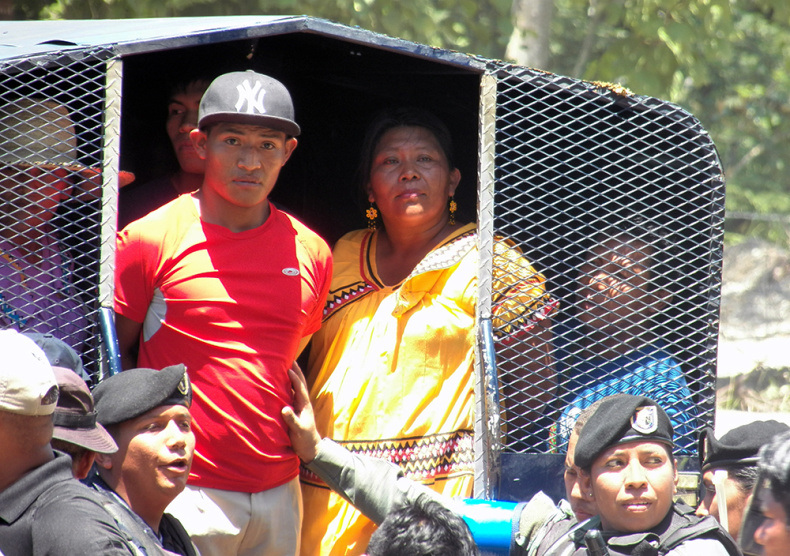
by DGR Colorado Plateau | Aug 6, 2015 | Colonialism & Conquest, Indigenous Autonomy, Obstruction & Occupation
By Richard Arghiris / Intercontinental Cry
Protests against the Barro Blanco hydro dam in western Panama turned violent last Saturday, July 25, when riot police, claiming to act in self-defense, unleashed pepper spray and batons on some 50 Ngäbe activists, women and children among them. At least three protesters were badly injured in the clash.
The crackdown occurred during a visit to the area by the Panamanian Vice President Isabel Saint Malo, who, under the pretext of dialogue, convened three Ngäbe leaders behind closed doors at the Centro Misionero (Mission Centre) in the town of Tolé. Despite a reasonable request to be included in the meeting, leaders from local community groups were excluded. Activists responded to Saint Malo’s move by blockading the Carretera Interamericana, the country’s principle highway.
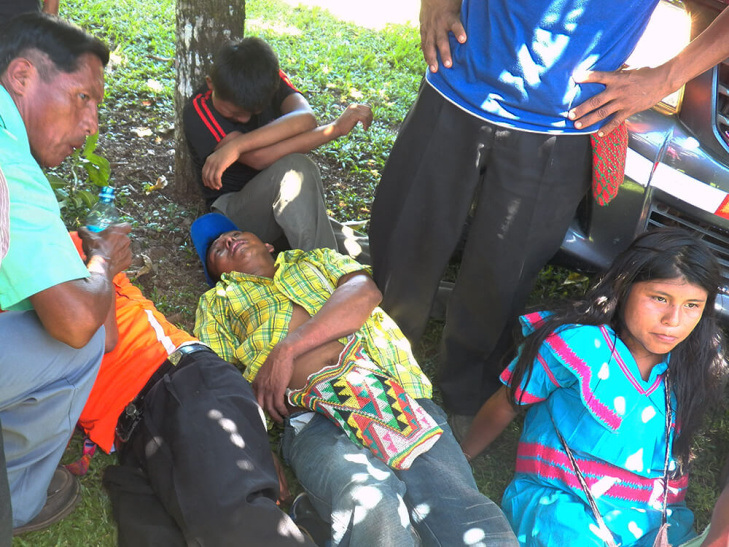
Protesters, including women and children, recover after clashes with the police. (Photo: Oscar Sogandares)
According to the Ngäbe, at around 10:15 am, in scenes reminiscent of the Martinelli years, the police reacted violently to disperse the 50-strong protesters, destroying their equipment, trashing their camps, and burning their banners.
The police deny improper use of force.
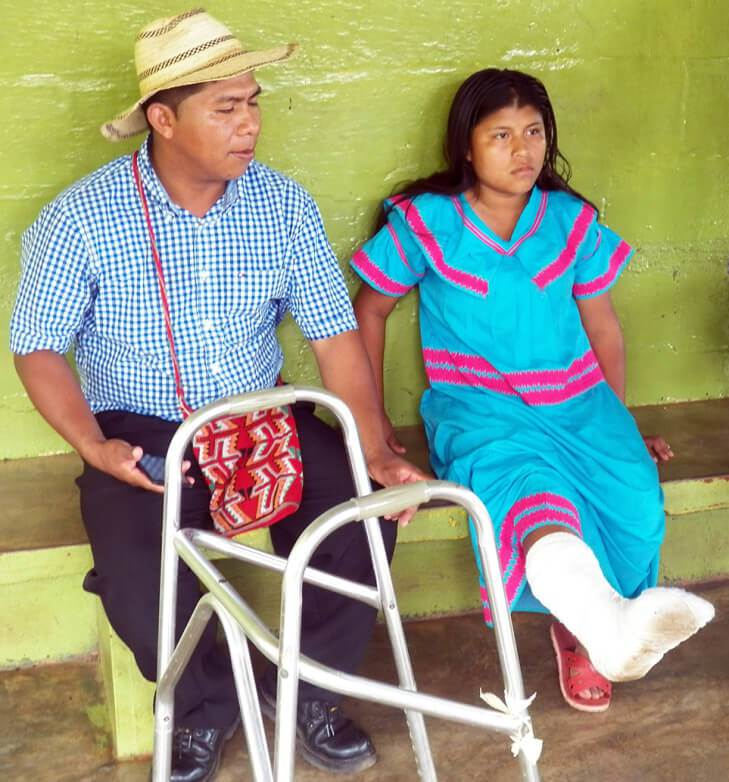
Edilma Pinto, 17, suffered a fractured foot during the police crackdown. (Photo: Oscar Sogandares)
Many fled the scene before 20 people were arrested (including several minors) and dispatched to the city of Santiago for processing.
While in the private meeting with Saint Malo, the Cacique of Muná, Chito Gallardo, and the Mayor of Muná, Rolando Carpintero, learned of the arrests and quickly intervened to have them returned. The injured were soon taken to the Casa Misionero for treatment and for the Vice President to bear witness.
According to one person at the scene, the vice president appeared coolly uninterested.
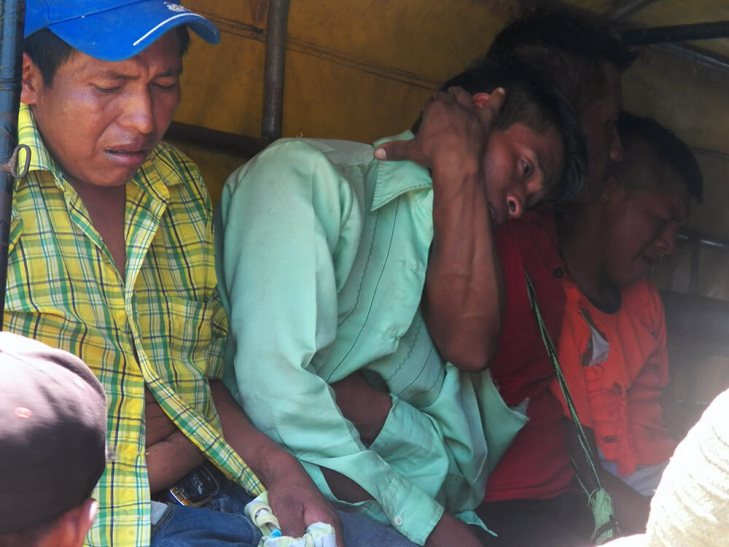
Some 20 Ngäbe protesters were detained by the police. (Photo: Oscar Sogandares)
For several weeks, hundreds of police units have been stationed in and around Tolé, including numerous SENAFRONT troops, an elite militarized squad funded in part by the United States. SENAFRONT is normally charged with defending the jungle frontier with Colombia, making their presence of considerable significance.
Under the US Leahy Law on Human Rights, the US Department of State is prohibited from providing military assistance to foreign units who violate human rights with impunity.
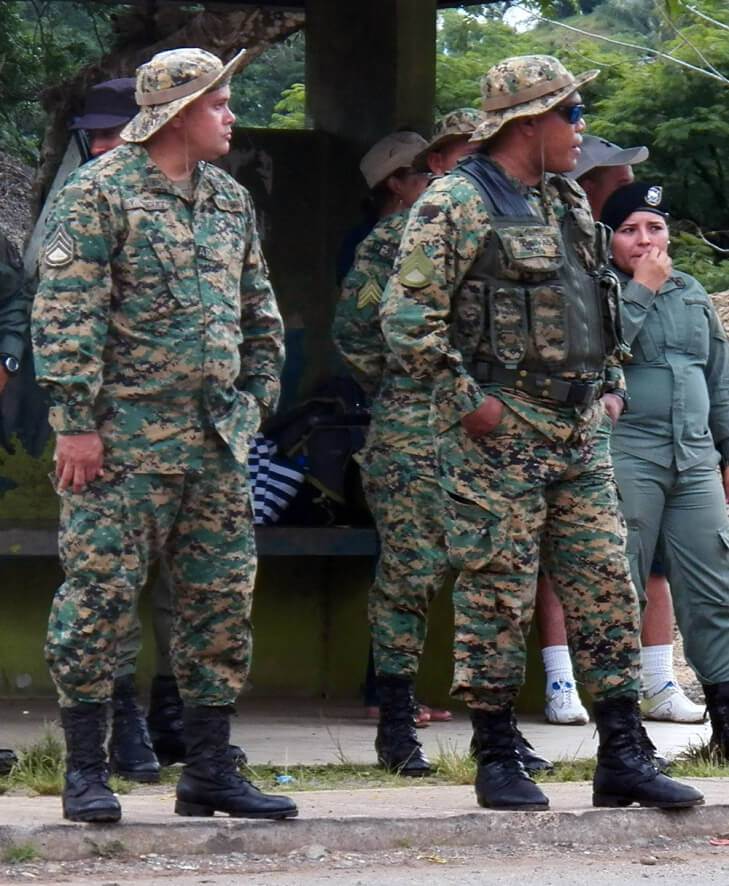
Partly funded by the US State Department, elite SENAFRONT troops have been dispatched to the area. (Photo: Oscar Sogandares)
The clashes on the Interamericana foreshadow greater unrest as Barro Blanco’s owner, Generadora del Istmo (GENISA) – a corporation owned by the controversial Kafie family, now mired in a high-level corruption scandal in Honduras – scrambles to complete the final 5-10% of the hydro dam’s construction.
The company has never sought the free, informed, and prior consent of the indigenous communities living on the banks of the Tabasará river, while the project’s funders, the Dutch and German investment banks FMO and DFE, admit to failing their own due diligence tests. Unfortunately, all funds have now been dispensed to GENISA and the banks themselves made a point of threatening the government when it suspended the project earlier this year.
The negative impacts of Barro Blanco have been identified by scores of technical teams, independent experts, international observers, and the United Nations. Those same impacts are nowhere to be found in GENISA’s Environmental Impact Assessment. Among them, the dam will displace several indigenous and campesino communities, including the community of Kiad, where a unique school and cultural centre is developing the written script of the Ngäbere language.
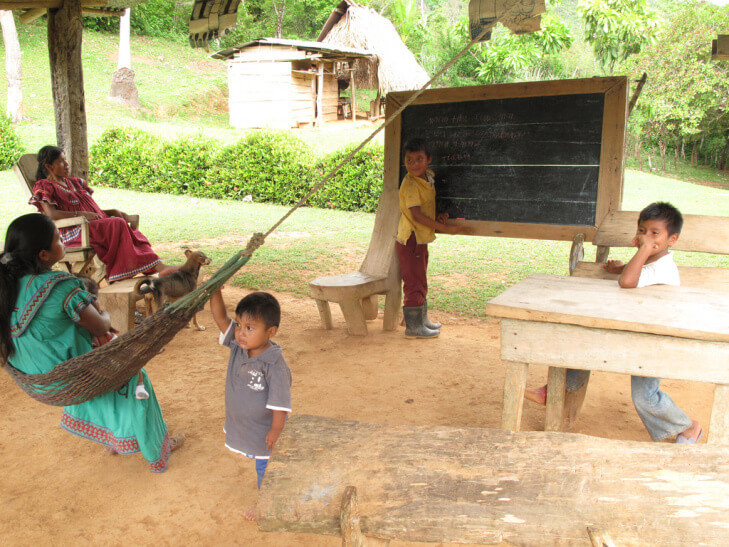
The ancient Ngabere language is taught at this school house in Kiad. (Photo: Richard Arghiris)
Additional impacts include the loss of farm plots and fish stocks — vital sources of sustenance for indigenous and campesino communities in the region – as well as the loss of several ancient petroglyphs, part of Panama’s national patrimony and a special significance to the Mama Tata religion, a Ngäbe revivalist movement that syncretises indigenous animism and Catholicism.
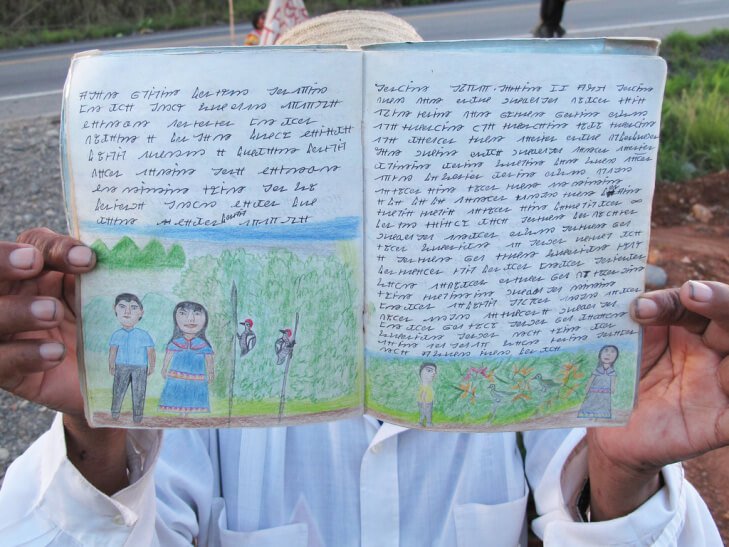
The Ngabere language is a great source of cultural pride. (Photo: Richard Arghiris)
Among the most devout followers of Mama Tata are the M22 resistance movement, who successfully blockaded the entrance to the dam for 38 consecutive days – until just ten days ago. International news footage of the groups praying and dancing on the highway may have influenced the government’s decision to enforce a ‘soft’ take-over of the site entrance. In contrast to the force deployed outside Tolé, Ngäbe women lying in the path of machinery were carefully removed.
Construction of the dam has now resumed and M22 are continuing to pray day and night by the highway. They complain of psychological intimidation with the police shining high intensity lamps on their camp during the night and aggressively entering the temple they have built near the river banks.
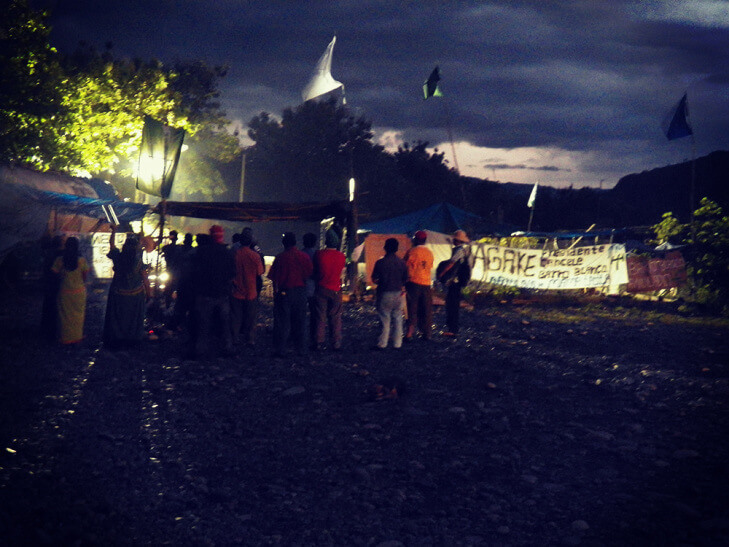
Days before their eviction from the site entrance, M22 gather for prayers under police spotlights. (Photo: Oscar Sogandares)
For his part, Panamanian President Varela, who continues to talk condescendingly about giving the Ngäbe ‘the keys to the dam’ upon its completion, appears to have acquiesced to pressures from his own business community, tacitly enabling foreign corporations who respect neither the environment nor international law nor indigenous or human rights.
The Supreme Court has cheered him on by annulling a moratorium on hydro projects passed by the environment agency, ANAM, who were concerned with the stress being placed on Panama’s delicate but biologically rich watersheds. With the crackdown last week, the Panamanian government appears officially back to business as usual.
From Intercontinental Cry: https://intercontinentalcry.org/barro-blanco-protesters-injured-and-arrested-28467/#imageclose-28472
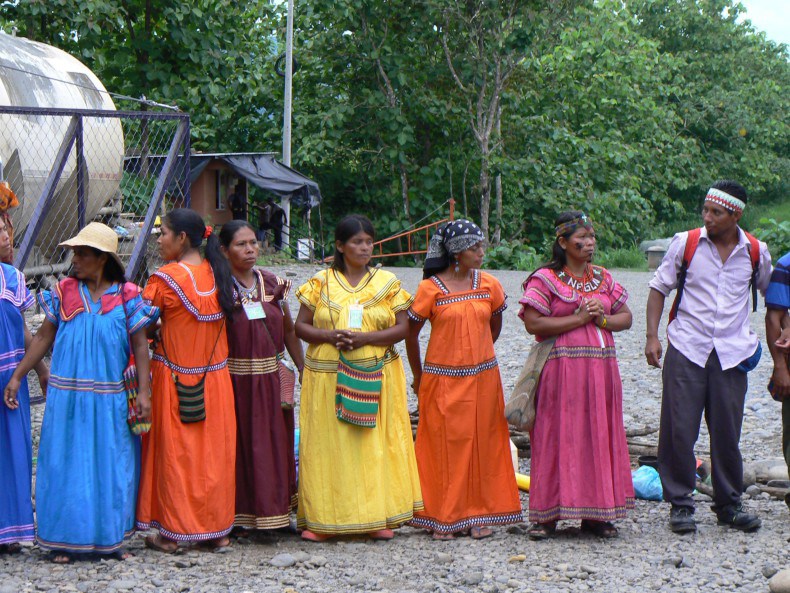
by DGR Colorado Plateau | Aug 5, 2015 | Biodiversity & Habitat Destruction, Colonialism & Conquest, Indigenous Autonomy, Obstruction & Occupation
By Richard Arghiris and Jennifer Kennedy / Intercontinental Cry
June 14, 2015
NGÄBE ISSUE ULTIMATUM TO THE GOVERNMENT OF PANAMA: CANCEL THE PROJECT BY MONDAY
A 30-strong splinter group of Ngäbe from the M10 resistance movement has blocked the entrance to the Barro Blanco hydroelectric dam in western Panama, preventing workers from entering the site. The 15 year struggle of the Tabasará river communities to protect their livelihoods, their culture, and their ancestral heritage now appears to be entering a tense new phase. With negotiations exhausted and the dam 95% complete, M10 has an issued an ultimatum for the government to cancel the project by Monday, June 15, 2015. It is unclear how the government will respond.
“Being Ngäbe-Buglé cultural patrimony,” said Clementina Pérez, part of the group camped at Barro Blanco’s gates. “Our river, our mother earth, our ecology, our existence, we are here to make known to the national and international community that this patrimony belongs to us and to the church of Mama Tata. With the conservation of peace, liberty, justice and unity, liberation and social justice… [we ask] the President of the Republic the cancellation and removal of the dam from our communities, our river and our mother earth, which belong to us as original people of the Americas…”
Funded by European banks – the German Investment Corporation (DEG) and the Dutch Development Bank (FMO) – the dam is set to inundate a string of Ngäbe and campesino communities, all of whom have voiced their objections from the outset. The flood will destroy ancestral petroglyphs, fertile agricultural grounds, and Mama Tata cultural centres, including a unique school where the emerging written script of the Ngäbere language is being developed and disseminated. The dam will significantly impact the river’s marine life, wiping out migratory fish species which many communities – both up and down stream – rely upon for essential protein. None of the Tabasará communities have provided their free, informed and prior consent to the dam, a fact recently confirmed by the FMO’s own independent complaints mechanism (ICM).
“Lenders should have sought greater clarity on whether there was consent to the project from the appropriate indigenous authorities prior to project approval,” said an ICM report, published on May 29, 2015. “[The plan] contains no provision on land acquisition and resettlement and nothing on biodiversity and natural resources management. Neither does it contain any reference to issues related to cultural heritage…”
The report is the latest in a series of professional analyses that pour a thick layer of scorn over the dam project’s owner, Generadora del Istmo (GENISA). Demonstrably unlawful, GENISA has been condemned by numerous independent investigators, the United Nations, several international NGOs, and Panama’s own environmental agency, ANAM, who found a raft of flaws and short-comings in their environmental impact assessment.
But despite failing their own due diligence, the banks appear to have shrugged off the ICM report with an insipid call for “constructive dialogue” and “a solution for a way forward.” In February this year, the FMO chose to threaten the government of Panama after building work was temporarily suspended on the recommendation of ANAM. Writing to the Vice President, the FMO warned that the suspension “May weigh upon future investment decisions, and harm the flow of long-term investments into Panama.”
The government seems to have taken this threat to heart. Panama’s president, Juan Carlos Varela, who was elected to office in 2014, flip-flopped on Barro Blanco before finally falling in line. Last week, while proffering flimsy reassurances about having found a human rights solution, his government left the negotiating table and signaled an end to the suspension of works. M10 claims the work never stopped and has been continuing clandestinely. They are now mobilizing for action.
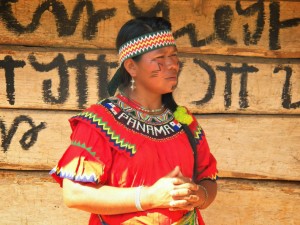
Clementina Perez (Photo: Oscar Sogandares)
“If this situation is not resolved,” said Clementina Pérez, “We will go to the Panamerican highway to ask together, at a national level, the cancellation of Barro Blanco…”
Rising with stark grey walls above the denuded banks of the Tabasará, Barro Blanco has become a symbol of the previous administration, its fundamental violence and contempt for the rule of law. The former President Ricardo Martinelli – now on the run in the United States and facing a corruption probe back home – provoked no less than four major uprisings as he grasped for land and resources in Panama’s indigenous territories. Heavy-handed repression resulted in the deaths of several protesters and bystanders, including an unarmed teenage boy who was shot in the face by police. Barro Blanco is the visible legacy of a proudly thuggish President who serially abused Panama’s Indigenous Peoples and plundered the country at will. Thus far, Varela has been keen to strike a more decent and humane tone. How he now handles the crisis evolving on the banks of the Tabasará River will be a demonstration of his sincerity, or lack of.
From Intercontinental Cry: https://intercontinentalcry.org/ngabe-block-entry-to-barro-blanco-hydro-dam-panama-28186/
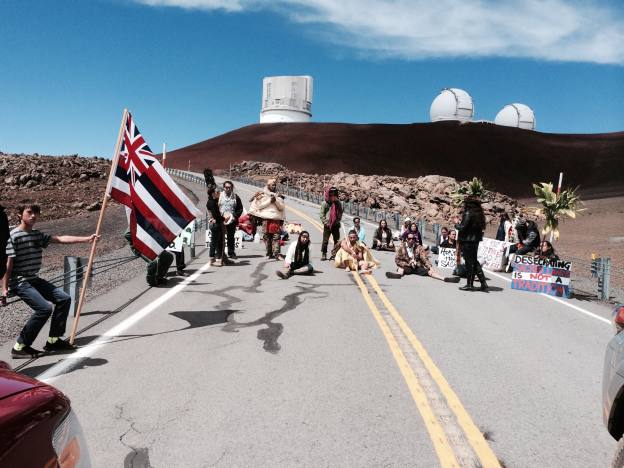
by DGR Colorado Plateau | Jul 30, 2015 | Colonialism & Conquest, Mining & Drilling
By Will Falk / Deep Green Resistance
Many view the debate surrounding the Thirty Meter Telescope’s proposed construction on Mauna Kea and Kanaka Maolis’ opposition to it as fundamentally a question of science versus culture. On the benign end, the word “science” has come to connote something close to cool and objective rationality – nothing more nor less than a collection of knowledge to be used in man’s (isn’t it always “man’s”?) noble aim to transcend nature. More malevolently, however, pitting science against indigenous culture is nothing more than insidious racism. This racism operates on the often unchallenged claim that science is an inherently western way of knowing and therefore superior to indigenous ways of knowing.
In fact, some Mauna Kea protectors wish to avoid this rhetorical ploy so strongly they can be heard saying, “We’re not against science, we’re just against building this telescope on Mauna Kea.” Their words imply that the telescope could be built somewhere else and western science allowed to run its course everywhere but here.
Personally, I am against the construction of telescopes anywhere and I have lots of problems with western science. I am careful to emphasize the adjective “western” in western science because Kanaka Maolis often remind me that they’ve always known many of the things western science claims to have discovered. Remember, as Mauna Kea protector Hualalai Keohula has reminded me, that Kanaka Maoli navigated the world’s largest and greatest ocean in canoes built with wood and stone, aided with nothing more powerful than the naked human eye, centuries before the West realized the world was round. This, it should be said, is the right way, the least destructive way, the non-violent way to practice astronomy.
I speak only for myself, here, but I will go so far to say I wish western science never existed. I know in today’s dominant culture my wish is pure blasphemy. As my friend Derrick Jensen noted in his brilliant work Dreams, science is the new monotheism. The old monotheisms – Christianity, Judaism, Islam – succeeded in removing meaning from the natural world and placed meaning in the hands of a jealous, abstract God dwelling in far-off heavens. Science, then, erased God and obliterated any possibility of meaning with Him. When I make these arguments, I’ve found it to be like Jensen has observed, when you blaspheme God, you are called a disbeliever. When you blaspheme science, you are called an idiot.
Still, on the whole, science has been a disaster for life on Earth. The first problem with science is the first problem with so many products of the murderous culture we live in. The first problem with science is science’s epistemology is rooted in this culture’s epistemology. And, this culture’s epistemology is based on domination. Epistemology is the study of how we know what we know.
One way to understand science is to trace what the leading scientific epistemologists have to say. Remember Sir Francis Bacon from your 6th grade science class? He invented what we call today “The Scientific Method.” He said his “only earthly wish is to stretch the deplorably narrow limits of man’s dominion over the universe” by “putting her (nature) on the rack and extracting her secrets.” As if that wasn’t scary enough, Bacon went on to say, “I am come in very truth leading you to Nature with all her children to bind her to your service and make her your slave.”
Or what about the hugely popular science apologist, Richard Dawkins? He writes in his book A Devil’s Chaplain: Reflections on Hope, Lies, Science, and Love that “Science boosts its claim to truth by its spectacular ability to make matter and energy jump through hoops on command, and to predict what will happen and when.”
“To make matter and energy jump through hoops on command” is a soft way to spell domination. Substitute yourself for “matter and energy” (that is what you are, of course). How would you feel if a scientist pointed a gun at you, or shot electrical currents through your muscles, or stuffed you into a cage, starved you, pumped your body full of chemicals and forced you to jump through hoops at his command?
The culture we live in is based on domination. How else do we account for the fact that one in five women will be raped in her lifetime? One in four girls and one in six boys sexually abused before they turn 18? How else do we account for the fact that 2.6 people are killed by American police every day?
Why, then, would we expect western science – a product of this culture – to be any different?
***
There’s a better way to judge science. It is a question that should form all of our moralities. The question is simple.”Is the real world better off because of science?” I think the answer to that question is a resounding no.
I come to that conclusion because my morality takes the needs of the real, physical world as primary. Water, soil, air, climate, my body, your body, and the food that sustains us are all formed by complex relationships of living beings. These living beings form the communities that make life possible. The needs of these communities must inform every action humans take. Anything else is suicidal.
I understand that science can be useful. Western science gives us modern medicine, for example, but modern medicine is more often than not a leaky band-aid applied to a wound created by science in the first place. Many tell me that western science is going to give us the cure to cancer while they forget that most cancers are produced by environmental toxins that exist because of science. I understand that western science can help us predict the devastating consequences of climate change, but science opened the road to the technologies responsible for climate change in the first place. Western science is responsible for napalm, agent orange, and atomic weapons. Of course, the surest way to prevent the destruction those weapons caused would have been to never open the doors of knowledge that lead to them.
The TMT project serves as a perfect reflection of the insanity of western science. Just like western science gains knowledge through domination, the TMT project is only possible through the domination of Kanaka Maoli. If the original people of Hawai’i were not exterminated by genocidal processes, were not made second-class citizens on their own islands, their culture not beaten to within inches of its life by American denationalization programs, Mauna Kea would be truly protected with the highest reverence.
But, western scientists have arrived, confident in the role Francis Bacon has laid out for them, to stretch Hawai’i on the rack and extract her secrets from her. The cops have come twice, with guns on their hips, to make Mauna Kea protectors vacate the Mauna Kea Access Road like Dawkins’ scientists who make matter and energy jump through hoops on command and arresting anyone who refuses the command.
Again, let’s ask the most important question of all. Is the real world better off with or without the TMT?
One way to answer this is to examine the physical processes needed to construct the TMT. Included in these physical processes are the actual materials used in construction. I am no expert on telescope construction and I’ve found it difficult so far to find detailed lists of the materials that will form the TMT (probably because acquiring these materials are a disaster for the environment.) From what I can tell, though, the TMT will be built with materials like steel, aluminum, and other rare earth metals.
You cannot have the TMT without steel, aluminum, and other rare earth metals. You cannot have steel, aluminum, and other rare earth metals without mountain top removal, open pit mining, and the combustion of vast quantities of fossil fuels. You cannot have mountain top removal, open pit mining, and the combustion of vast quantities of fossil fuels without climate change, mass extinctions, the forced removal of indigenous peoples, and the violent labor conditions present in extraction industries. So, before the materials needed to build the TMT ever even arrive in Hawai’i, they will be covered in the blood of humans and non-humans alike.
Telescopes are a disaster for the real world just like western science has been. Telescopes cannot be anything other than disasters for the real world because they are products of a murderous system of knowledge. It might be really super cool to discover the 832nd star in the 412th known galaxy with a new, massive telescope. This knowledge, however, comes through the domination of life on earth.
Mauna Kea – and I would argue all mountains – might be best understood as a complex community of living creatures living in mutual relationship. The needs of this community trump the desires of science. Mauna Kea itself acts as a giant water filter and houses the largest freshwater aquifer on Hawai’i Island. Everyone needs clean drinking water, but there have already been seven documented mercury spills associated with the telescopes on Mauna Kea. Currently threatened, endemic species call Mauna Kea home. The needs of mamane trees and ahinahina to live trumps the curiosity of astronomers to peep at other worlds.
***
Before I finish, let me anticipate the objections I will receive. Yes, I am quite aware of the comforts brought to some of us by western science. But, when we talk about how great science is for “us,” who are we talking about? Are we talking about the few indigenous societies clinging to their traditional ways of life, clinging to the only human ways of life that were ever truly sustainable? Are we talking about polar bears? Sumatran tigers? Bluefin tuna? We can’t be talking about West African black rhino because they just fell into the deepest dark of total extinction.
I know that science produced the internet, the laptop I’m typing on, and brought the delicious cold brew coffee I’m drinking. People often criticize me asking, “How can you condemn these wonderful tools you are using? You get on planes and travel to Hawai’i, you get in cars to visit places across Turtle Island, aren’t you a” – and they gasp – “a hypocrite?”
My answer is simple. Yes, I might be a hypocrite, but I believe my friend Lierre Keith who said, “Understand: the task of an activist is not to negotiate systems of power with as much personal integrity as possible – its to dismantle those systems.” Western science is a system of power and must be dismantled if we have any chance of surviving the catastrophe facing us. Sitting Bull used American made rifles to defend his people from American cavalrymen. Ken Saro-Wiwa, the Nigerian poet who was murdered for resisting Shell Oil in his homeland, wrote in English – the language of his oppressors.
I wish with all my heart that I could live as our ancestors lived – a life free from the deepest anxiety that in a few years everything might be gone. I was raised in the Wasatch and Uinta Mountains of Utah – a place I just visited – and I wish with all my heart that I could spend my life walking in Indian paintbrush, columbine, daisies, and lupine consumed in the total wonder and beauty of life. I wish with all my heart that I could sit still in simple expression of the love I feel. But, while everyone I love is under attack, it is simply unforgivable not to do everything within my power to protect them. It is simply unforgivable not to use every tool at my disposal to defend them.
History reveals western science as an accomplice to the murder of the real world. Western science is attempting the murder of Mauna Kea. Mauna Kea and the real world demand that we stop it.
Will Falk has been working and living with protesters on Mauna Kea who are attempting to block construction of an 18-story astronomical observatory with an Extremely Large Telescope (ELT).
Find an index of Will Falk’s “Protecting Mauna Kea” essays, plus other resources, at:
Deep Green Resistance Hawai’i: Protect Mauna Kea from the Thirty Meter Telescope
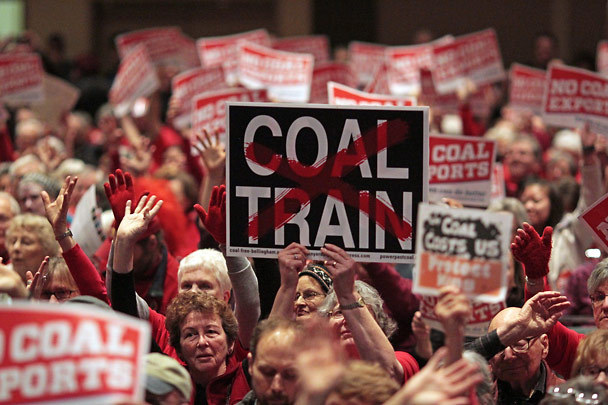
by Deep Green Resistance News Service | Jul 28, 2015 | Climate Change, Lobbying, Strategy & Analysis
By Thomas Linzey / CELDF
Four years ago, as we were leaving Spokane to help rural Pennsylvania communities stop frack injection wells and gas pipelines, this region’s environmental groups couldn’t stop talking about “stopping the coal trains.”
After people in British Columbia – including NASA’s top climate scientist James Hansen – were arrested for blocking oil trains; and after people in Columbia County, Oregon have now proposed a countywide ban on new fossil fuel trains, one would think that both the Spokane City Council and the region’s environmental groups would have begun to take strong steps here to, well, actually stop the coal trains.
After all, there is now almost universal agreement that the continued use of fossil fuels threatens almost every aspect of our lives – from scorching the climate to acidifying the oceans and fomenting widespread droughts.
But it seems that both the Council and this region’s environmental groups have resigned themselves to being silent accomplices to this slow-moving disaster.
A few weeks ago, at a forum on coal and oil trains, rather than propose a citywide ban on oil and coal trains, those groups instead focused on the dangers of train derailments and coal dust – two real issues to be sure – but ones that fall completely short of recognizing the underlying problems posed by the trains.
If the problem is derailments and dust, then the solution is to reinforce and cover the railroad cars. That may or may not happen, but even if it does, it doesn’t solve the fundamental problem posed by the coal and oil trains. Instead, such a stance broadcasts the message from the City of Spokane and this region’s environmental groups that the coal and oil trains are okay as long as they are “safe.”
The real problem, of course, is that the fossil fuels that the oil and coal trains carry – when used the way they are intended to be used – can never be made “safe” because their guaranteed combustion is slowly boiling the very planet on which we live.
At the end of Spokane City Council President Ben Stuckart’s presentation at the forum last week, he spoke about his dead-end meetings with state and federal officials, whose doors were open to the energy and railroad corporations but not to communities affected by the trains. Stuckart declared that he wasn’t sure that anything short of laying down on the tracks would stop the coal and oil trains.
For one brief shining moment, it seemed that the heavens had parted and what we’re really up against – a governmental system controlled by the very corporations it is ostensibly supposed to regulate – came shining through.
As I watched, people across the room began to shout and applaud; and then, just as quickly as it had come, it passed, as the hosts of the forum steered everyone back to their latest moving target – this time, urging people to write letters begging Governor Inslee to stop proposed oil and gas exports. In other words, now nicely asking the Governor to stop more oil and coal trains from invading Spokane.
I then realized why I stopped going to those gatherings – I stopped because the form of activism proposed by the groups actually strips us of the belief that we’re capable of doing anything by ourselves, as a community, to actually stop the trains. Writing letters reinforces a hopelessness of sorts – that we’re completely dependent on the decision by others to “save” us, and that we’re incapable of taking action to save ourselves.
It would be akin to the civil rights movement writing letters to congress instead of occupying the lunch counter or the seats at the front of the bus. Or Sam Adams sending a letter to King George urging him to put safety bumpers on the ships carrying tea, rather than having a tea party by dumping casks of tea in the harbor.
Until we confront the energy and railroad corporations directly, they will continue to treat Spokane as a cheap hotel. We need to ban and stop the trains now – using everything that we can – before future generations wonder why we spent so much time sending letters and so little time protecting them.
Thomas Alan Linzey, Esq., is the Executive Director of the Community Environmental Legal Defense Fund and a resident of the City of Spokane. The Legal Defense Fund has assisted over two hundred communities across the country, including the City of Pittsburgh, to adopt local laws stopping corporate factory farms, waste dumping, corporate water withdrawals, fracking, and gas pipelines. He is a cum laude graduate of Widener Law School and a three-time recipient of the law school’s public interest law award. He has been a finalist for the Ford Foundation’s Leadership for a Changing World Award, and is a recipient of the Pennsylvania Farmers Union’s Golden Triangle Legislative Award. He is admitted to practice in the United States Supreme Court, the Third, Fourth, Eighth, and Tenth Circuit Courts of Appeals, the U.S. District Court for the Western and Middle Districts of Pennsylvania, and the Commonwealth of Pennsylvania. Linzey was featured in Leonardo DiCaprio’s film 11th Hour, assisted the Ecuadorian constitutional assembly in 2008 to adopt the world’s first constitution recognizing the independently enforceable rights of ecosystems, and is a frequent lecturer at conferences across the country. His work has been featured in the New York Times, the Los Angeles Times, Mother Jones, the Nation magazine, and he was named, in 2007, as one of Forbes’ magazines’ “Top Ten Revolutionaries.” He can be reached at tal@pa.net.
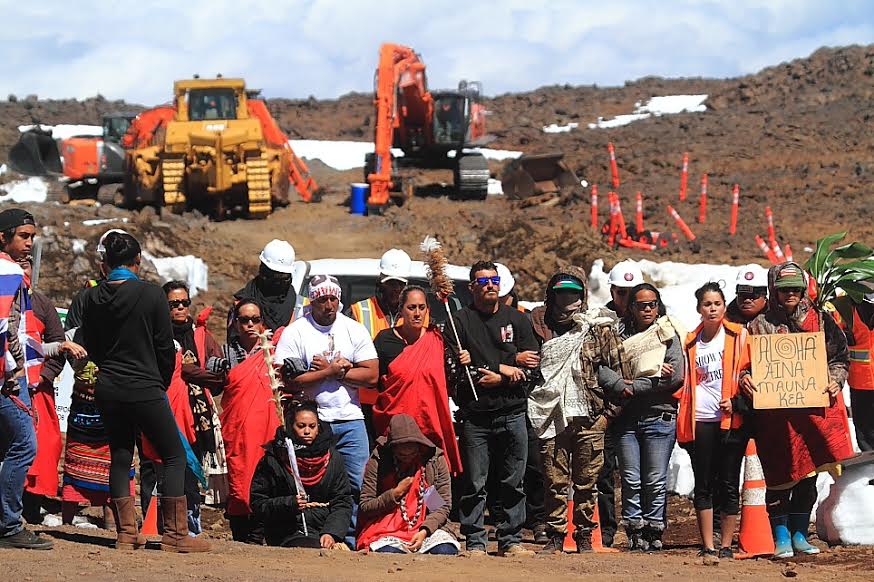
by DGR Colorado Plateau | Jul 9, 2015 | Colonialism & Conquest
By Will Falk / Deep Green Resistance
Sitting outside the 10 by 20 foot makeshift tent that has served as my home for the last 34 days on Mauna Kea, I watch the tent poles shudder to the concussion of US Army howitzer cannons firing live shells at their training grounds below. When the wind blows just right, from the south, the rattle of automatic rifle fire reaches the occupation. There’s no denying it: A war rages in Hawai’i.
It’s a war on native peoples, a war on women, a war on the land, a war on life itself. The war did not start in Hawai’i. The war began thousands of years ago with the dawn of civilization when some humans chose to live in population densities high enough that they overshot the carrying capacity of their homelands and turned to dominating other peoples in other lands. Imperialism was born, and one-by-one land-based, truly sustainable human societies were either eradicated or forced into assimilation.
The war swept west across Turtle Island (so-called North America) – where it is still being fought -leaving whole peoples destroyed and now largely forgotten. The war is carving peaks from mountains, drying rivers so they no longer flow to their ocean homes, and boiling the planet’s temperature to levels dangerously close to being unbearable for all but a few lifeforms. The war decimates the numbers of our animal kin, too. Buffalo walk the ledge above total extinction. So do salmon. So do timber wolves. So do grizzly bear.
The war in Hawai’i began in the late 1770s when Captain Cook first appeared. By 1897, a million Hawaiians were killed in battle, by introduced diseases, and through Christian missionary efforts. Half of Hawai’i’s endemic species have been exterminated since European contact. The minds of Hawaiian children were attacked when the illegal Republic of Hawai’i outlawed the Hawaiian language in Hawaiian schools in 1896. The bodies of these Hawaiian children were attacked when they were beaten for speaking their native tongue.
A genocidal program of desecration was initiated as well. Hale O Pa’pa and the Kanaka burials there were paved over by highways while Kahoolawe was bombed to hell by the American military – and that’s just to name a very few of the sites desecrated. Now, the TMT project wants to dynamite an eight acre patch of Mauna Kea’s hallowed summit to clear the way for their telescope.
***
Rumors are swirling that the TMT (Thirty Meter Telescope) project is poised to break its self-imposed moratorium on construction and send its equipment up the mountain with an armed escort. We have heard that Gov. David Ige is willing to send the national guard against the Mauna Kea protectors.
In the midst of these rumors, it is not uncommon to hear people say they hope the situation on Mauna Kea will not turn violent. The problem with expressing this hope is the situation on Mauna Kea is violent, has been violent for a long time, and will remain violent so long as those in power remain in control of the land.
Before you object to this, consider the bombs and rifle fire I am listening to as I write this.
Consider that the first time construction equipment tried to force a way over the objections of the Hawaiian people, it came with men carrying batons and pistols. These men carrying batons and pistols put 31 peaceful protectors in handcuffs, carried them to the Hilo jail, extracted 250 dollars from each one of them, and now force them to appear at a series of of court dates under threat of jail time.
Consider that David Ige, as I wrote earlier, has stated that he is willing to call in the national guard to clear the way for the TMT. Speaking of war, the national guard is an organization of soldiers. They will come with rifles instead of the police’s pistols.
This is violence.
I didn’t even mention the violence already done to Mauna Kea to build and maintain the 13 telescopes that already exist on the summit. These 13 telescopes required their own dynamite and 38 feet have been cut from the height of Mauna Kea’s summit already. There have been 7 reported mercury spills on the mountain that contains Hawai’i Island’s largest freshwater aquifer.
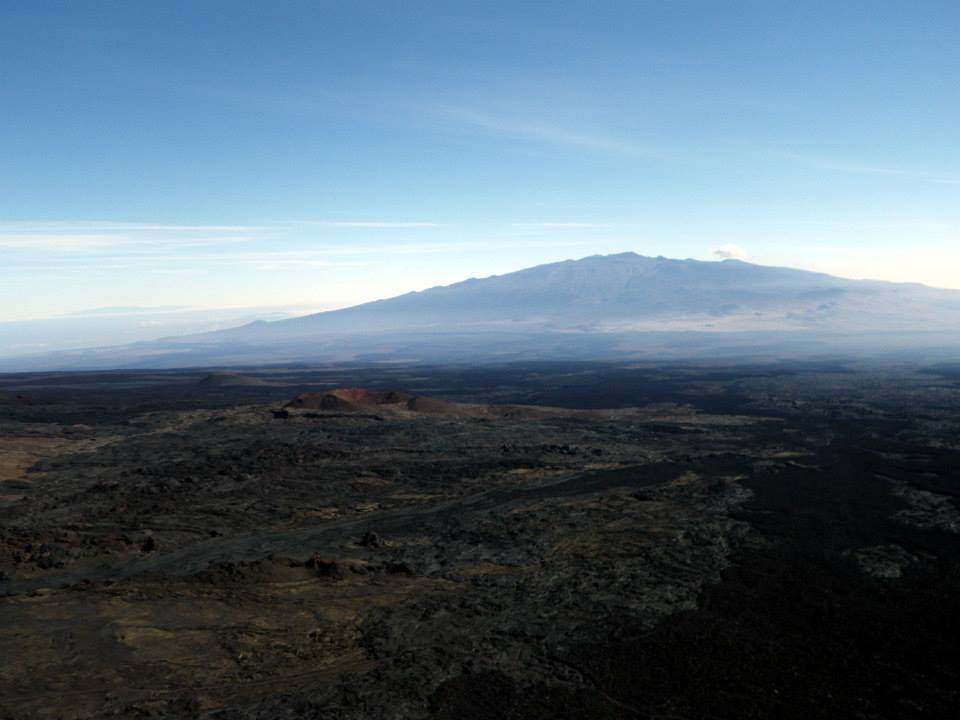
Mauna Kea
Plants, animals, and insects that live on Mauna Kea are murdered by this mercury and its more than likely that humans – especially children and the elderly – are harmed by this mercury, too.
Kanaka Maoli are genealogically related to Mauna Kea – it is literally a family member – so to do this kind of violence to the Mauna is to attack an older sibling.
Again, this is violence.
I anticipate that some may accuse me of encouraging an atmosphere of violence by using words like war to describe the violent reality facing Mauna Kea, facing Kanaka Maoli, and facing the long, necessary road to Hawaiian independence. Describing reality, however, is not the same thing as encouraging violence. I want this violence to stop and the first step to a cure is the proper diagnosis.
As a haole, I understand that when push comes to shove the State will crack down much harder on people of color than they will white people, and I do not want to provoke this crack down. I do think, though, that we need to be prepared to react when the State does not treat the protectors with the kapu aloha that the protectors will show those who come to destroy Mauna Kea.
Those who deny we are at war are wrong. Maybe, they cannot recognize the war because war has become so utterly pervasive. The wars of the past led to the rape of women. The war we’re fighting now causes one in six women to be raped in her lifetime worldwide. The wars of the past were fought to beat armies, to eradicate cultures, and to topple nations. The war we’re fighting now causes the extinction of whole species – 200 species a day, in fact, day after day after day.
Maybe, they cannot recognize the war because they are privileged enough not to confront the reality of this war. I think Palestinians understand this war. I think Catholics in Northern Ireland understand this war. I think Afghanis and Iraqis understand this war. I think hammerhead sharks, California condors, mamane trees, and ahinahina understand this war. They have to, because their survival depends on it.
Maybe, those who deny the war is happening think they can avoid the war’s dangers by ignoring it. It might be possible to avoid bullets, gas, and bombs by agreeing and cooperating with the cops as they place you in handcuffs, but you are just as susceptible to the environmental toxins the dominant culture unleashes on us every day. Denial saves no one from cancer.
Yes, Hawai’i with the rest of the world, is at war. This war – more than any other – is a war that we absolutely must win. If we lose, we lose life on this planet. To win a war, you must destroy your enemy’s ability to make war. The battle on Mauna Kea against the TMT is a mini-war in the larger war on life. The surest way to win this war is to undermine the TMT’s ability to build their telescope.
There are many strategies currently being employed to win this war – to undermine the TMT’s ability to build their telescope – but the weakness of most of these strategies is that they rely on our enemies to do the right thing. The countless sign-waving events conducted in support of Mauna Kea are designed to persuade the public of the justness of our movement. The incessant social media campaign we are waging is geared towards changing the hearts and minds of the world. The court cases challenging the TMT project, for example, rely on a judge to agree with the arguments made by our lawyers.
And why do we appeal to the courts to protect Mauna Kea? The answer is simple. If the judge rules in our favor, the decision will be backed with the full force of the State. The judge’s ruling and it’s enforcement will be backed with an organized group of men carrying guns – the police, or another organized group of men carrying bigger guns – the national guard. If we were to win in court and the TMT tried to build it’s telescope, it would be them and not us for once, who would be staring down the barrels of rifles. Of course, we do not trust the courts to do the right thing.
That’s why we stand on the Mauna Kea Access Road at this occupation.
Another way to say all this is: the State can, will, and already has used violence against us and our relations in the natural world. We must understand this in order to be effective. We must understand that writing really clever essays might not stop them. We must understand that hugging cops when they come to arrest us might not stop them. We must understand that we may not have an opportunity to place leis around the necks of national guardsmen when they point their guns at us.
I hear many people within the movement state confidently, “We will stop the TMT project.” But, if we do not understand the violence the State is capable of I feel like what we are really saying is “We will stop the TMT project as long as the police or the national guard agree to what we think are the rules.” I am not writing these things to cause despair. Rather, I am writing these things to encourage the deepest levels of commitment to protecting Mauna Kea.
Of course, those who think I am calling for violence demonstrate their own belief that only violence will stop the destruction of Mauna Kea, the destruction of Hawai’i, and the destruction of what is left of the world. I do not claim to know what will stop the destruction of Mauna Kea, but I do know that we must understand the way the State frames our tactics for us before we even begin. Once we understand this, we must ask tough questions.
I’ll walk my talk and begin: If the police or national guard overwhelms the protectors on the Mauna Kea Access Road, what do we do next?
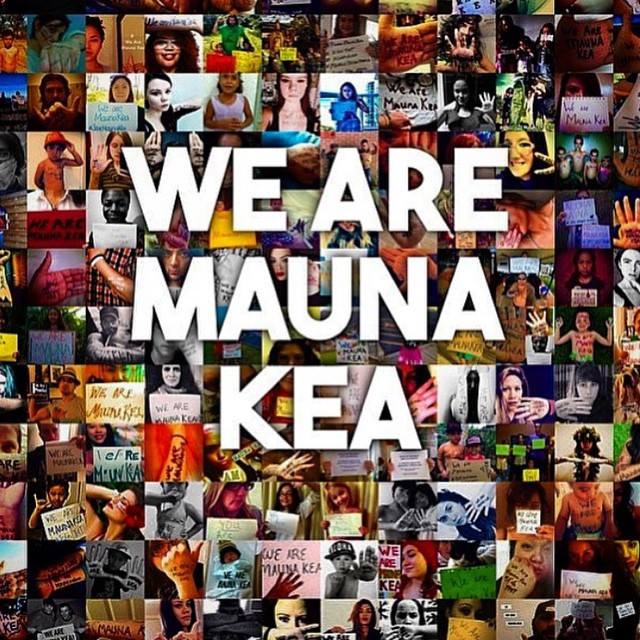
From San Diego Free Press: http://sandiegofreepress.org/2015/06/protecting-mauna-kea-this-is-a-war/
Find an index of Will Falk’s “Protecting Mauna Kea” essays, plus other resources, at:
Deep Green Resistance Hawai’i: Protect Mauna Kea from the Thirty Meter Telescope















